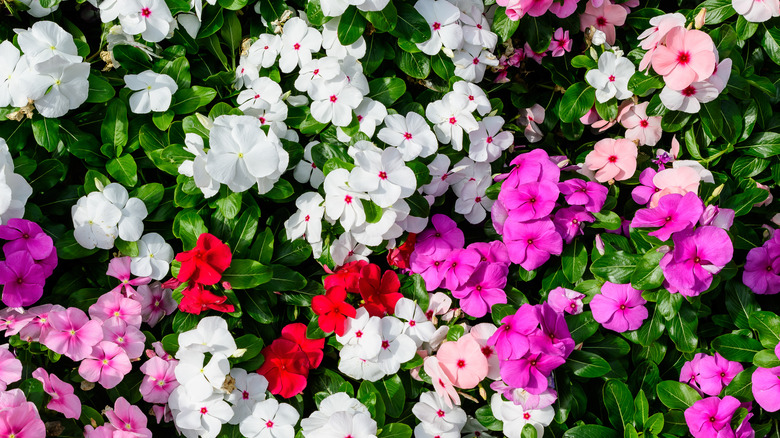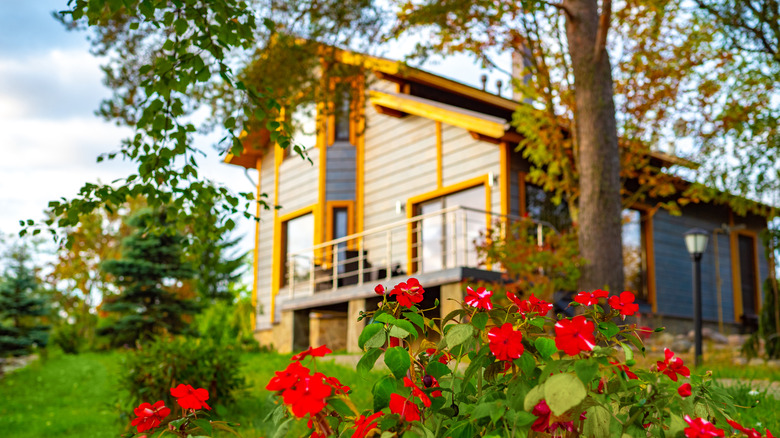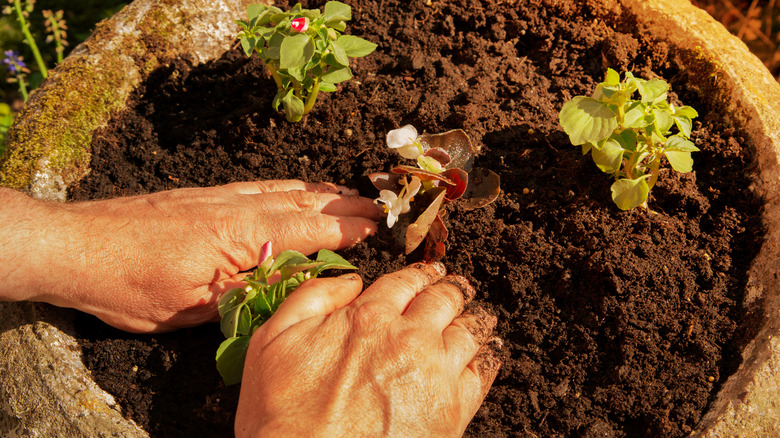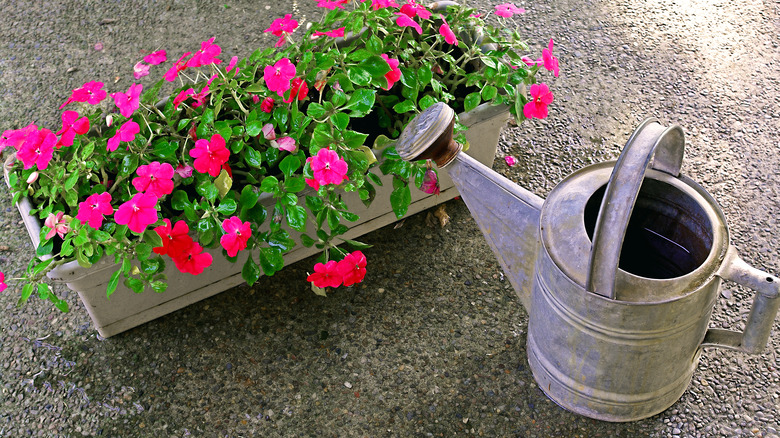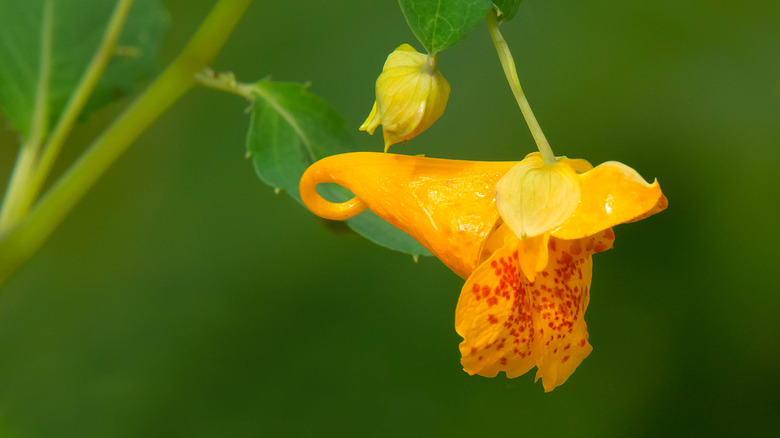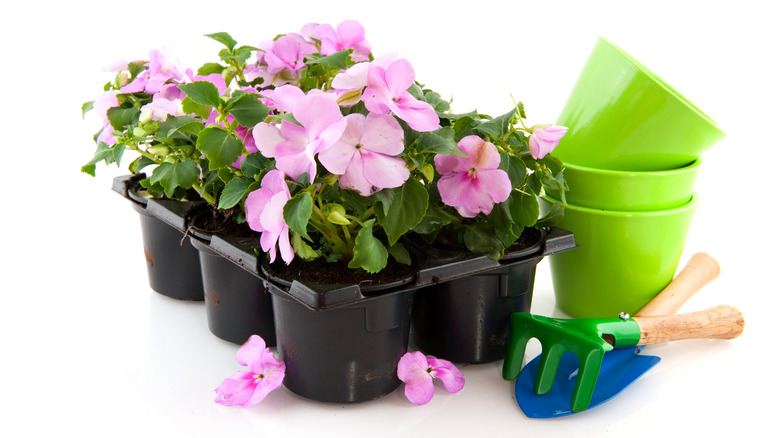Impatiens: Everything You Should Know Before Planting
The funny thing about the impatiens' name origin is it came from the plant's ... well, impatience to spread seeds. Their pods open easily and impatiens self-sow well, especially since the seeds tend to tumble everywhere. Also known as Impatiens spp., busy Lizzie, patient Lucy, and touch-me-not plant, impatiens grows as a perennial in USDA hardiness zones 10 to 11, and as an annual in most other places. These easy-to-cultivate flowers bloom quickly and come in a variety of types and colors such as pink, yellow, red, white, and purple, according to Garden Design.
While you can use seeds or cuttings to install impatiens in your garden, most people purchase starter plants from the nursery. If you go this route, make sure you keep the seedlings watered if you wait to put them into the ground. Impatiens like their H2O and may wilt if they are deprived from the substance (via Gardening Know How).
The plants can become tall — old-fashioned versions shoot up to two feet, while more modern types are a bit shorter, say 6 inches high and 10 to 12 inches wide. Impatiens like some shade; too much sun and their blooms fade, as per the Gardening Channel. Thinking of including this flower in your yard? Here are some other things for you to consider.
How to use impatiens in garden
You can expect impatiens to grow quickly — and they also produce an abundance of bright-colored blooms. This means the plant works well in many situations: You can use impatiens in all types of plant containers, from window boxes to hanging baskets. Additionally, since the flowers come in pastel tones, they work as accent plants in an English or cottage-themed garden.
Impatiens provide constant blossoms — from spring until the first frost — so you can count on them to brighten up any border on a consistent basis. For the same reason, they work well as ground cover under shrubs or trees, adding cheeriness to the greenery, as noted by Garden Design. They also fill in any color gaps as you wait for some of those perennials to flower. Impatiens also play well with others, which means they make terrific companion plants. Not only do they attract beneficial insects to the area, but their fleshy stems retain water. This allows impatiens to thrive in droughts, and they won't monopolize all the water from the plants surrounding them. When planted with other impatiens, all the leaves spread until they cover the soil, keeping it moist for the other flora in the area, says Gardening Know How.
Animal lovers never need to worry when planting impatiens. They are not toxic to dogs and cats so if accidentally ingested, no harm occurs. If your furry friend likes chewing on impatiens, you can discourage this with pet-avoidance spray (via Hunker).
How to grow impatiens
Before planting impatiens consider the soil the intended area contains. Impatiens like rich, moist, and well-drained soil. You can prep the dirt by mixing in compost or a slow-releasing fertilizer. Impatiens also prefer some wind shelter and light to medium shade. Cold weather won't encourage growth, so wait until the last spring frost before planting (see local frost dates here). You'll want the sun to warm the earth before putting impatiens into the soil.
When planting, keep in mind that the closer you put the seeds or seedlings, the taller the impatiens grow. So for flower beds or undergrowth areas, you'll want to space them apart about 8 to 12 inches so the plants remain closer to the ground; that way they fill out that section more, according to The Old Farmer's Almanac.
If your spring garden includes containers, much of this advice remains the same. You do want to find a well-draining potting soil with a slow fertilizer that will spur the impatiens' growth. Another thing to consider is what varieties to use; you can make all kinds of combinations, but do select plants that require the same amount of water and sun exposure (per Garden Design).
How to care for impatiens
Much of your success with raising flourishing impatiens is the result of regular watering. Gardening Know How recommends at least two inches each week; these plants like moisture or they will wilt. In a garden bed, you can retain this coolness by using a layer of mulch. If your impatiens live in a container or pot, daily watering is probably a must. Besides the initial slow-release fertilizer administered during the initial planting, impatiens planted in the ground may need nothing besides the water and mulch to sustain them. Containers, however, benefit from several liquid fertilizer feedings throughout the summer, shares Garden Design.
Pruning isn't needed with impatiens. If you do cut them back, you'll see new blooms form — but those will happen naturally as well since the flowers self-clean. This is one plant you never need to deadhead, according to Gardening Design. One worry you might have is downy mildew, though. In the past, some varieties have suffered from the condition, which deteriorates the impatiens so much it is better to remove them from your garden and start anew rather than treating the disease. Avoid this entirely by opting for mildew-resistant varieties such as impatiens walleriana or New Guineas. You can also prevent the mildew by watering the soil rather than the plant's leaves and ensuring there is enough space between plants to keep air circulating.
Varieties of impatiens
Impatiens come in a LOT of varieties — more than a thousand, according to The Spruce. Some of these have become popular to grow in North America, including impatiens walleriana, annual impatiens, New Guinea, and North American species, as noted by SF Gate.
- Impatiens walleriana comes from Africa and is always a perennial if grown in its native country. In the United States, however, the plant is an annual unless in a USDA hardiness zone of about 10 to 11. Like most impatiens, this type likes shade or semi-shady spaces and flowers regularly.
- Annual impatiens (impatiens balsamina) is also known as the garden or rose balsam, and is native to India and southeast Asia. While the above variety can reach heights of 3 feet, these types are smaller, only becoming as tall as 8 inches.
- New Guinea impatiens (impatiens hawker) come from ... New Guinea as the name states. This variety offers larger and brighter colored flowers. It is also unusual from the other impatiens in that it can flourish in full sunlight as long as you keep it moist.
- Jewelweed (above photo shows a spotted jewelweed) and touch-me-not (impatiens capensis and impatiens pallida) are actually wildflower species, but relatives of the annual and perennial impatiens. Their native woodlands lie in eastern and northern United States. These, too, enjoy a shady spot, moist soil, and can grow tall — up to 6 feet.
How to repot impatiens
While impatiens are easy to grow, they are also delicate and need gentleness during replanting. If you are moving established plants, you need to get the whole root ball out of the earth. Before putting them into a new home, look at the roots to see if they're white. Brown or damaged roots should be trimmed off before re-burying them, per Garden Guides. It is important for the plant be at soil level, or even a bit higher so the roots are fully covered. After replanting, you'll want to water the earth so the roots become secure in the dirt (via Gilmour). Be careful not to move the impatiens by holding the stem. These are brittle and easy to break — and if that happens the plant dies. Try grasping the leaves or root ball instead.
You may fertilize both potted impatiens and ones that grow in the ground; it's best to fertilize when you plant. For containers, many potting soils come premixed with fertilizer, but if you need to add some try a water-soluble one and put it around the plant's base. You can reapply fertilizer about every two weeks, explains SF Gate. If replanting in the ground, a slow-release fertilizer only needs two applications: in the beginning and then about halfway through the season. If you're using something that's water-soluble, you should reapply every two weeks. Keep these tips in mind and you'll have bright, beautiful impatiens all summer long!
